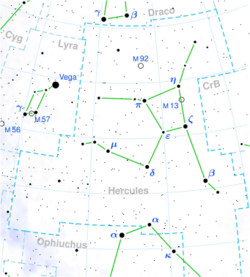Astronomy:Eta Herculis
| Observation data Equinox J2000.0]] (ICRS) | |
|---|---|
| Constellation | Hercules |
| Right ascension | 16h 42m 53.7653s[1] |
| Declination | 38° 55′ 20.116″[1] |
| Apparent magnitude (V) | 3.487[1] |
| Characteristics | |
| Spectral type | G7.5 IIIb[1] |
| U−B color index | +0.61[2] |
| B−V color index | +0.92[2] |
| Astrometry | |
| Radial velocity (Rv) | 8.3[1] km/s |
| Proper motion (μ) | RA: 35.58[1] mas/yr Dec.: -84.98[1] mas/yr |
| Parallax (π) | 29.11 ± 0.52[3] mas |
| Distance | 112 ± 2 ly (34.4 ± 0.6 pc) |
| Absolute magnitude (MV) | +0.84[4] |
| Details | |
| Mass | 2.13[4] M☉ |
| Radius | 8.9 ± 0.3[5] R☉ |
| Luminosity | 50[6] L☉ |
| Temperature | 4,900[6] K |
| Metallicity [Fe/H] | -0.28[7] dex |
| Rotational velocity (v sin i) | 8[8] km/s |
| Age | 1[6] Gyr |
| Other designations | |
| Database references | |
| SIMBAD | data |
Coordinates: ![]() 16h 42m 53.80s, +38° 55′ 20.116″
Eta Herculis (η Her, η Herculis) is a fourth-magnitude star in the constellation Hercules.
16h 42m 53.80s, +38° 55′ 20.116″
Eta Herculis (η Her, η Herculis) is a fourth-magnitude star in the constellation Hercules.
Properties
Eta Herculis is a G-type star. With a stellar classification G7.5IIIb, it is considerably larger than the Sun, having a mass that is 2.3 times solar and a radius 9.8 times.[6] Though it only shines with an apparent magnitude of 3.48, it is part of the "Keystone" asterism, visible overhead in the mid-summer night sky to northern observers, allowing it to be easily recognized. Eta Herculis is 50 times more luminous than the Sun.[6] The Hipparcos satellite mission estimated its distance at roughly 34.4 parsecs[3] from Earth, or 112 light years away.
If one follows the line connecting Eta Herculis with Zeta Herculis one comes across one of the earliest and most stunning globular clusters in the nighttime sky, M13, discovered in 1714 by Edmond Halley.
Eta Herculis is a double star once thought to be part of a binary star system.[6]
References
- ↑ 1.0 1.1 1.2 1.3 1.4 1.5 1.6 "* eta Her". SIMBAD. Centre de données astronomiques de Strasbourg. http://simbad.u-strasbg.fr/simbad/sim-basic?Ident=%2A+eta+Her.
- ↑ 2.0 2.1 Ducati, J. R. (2002). "VizieR Online Data Catalog: Catalogue of Stellar Photometry in Johnson's 11-color system". CDS/ADC Collection of Electronic Catalogues 2237. Bibcode: 2002yCat.2237....0D.
- ↑ 3.0 3.1 Perryman, M. A. C. et al. (July 1997). "The HIPPARCOS Catalogue". Astronomy and Astrophysics 323: L49–L52. Bibcode: 1997A&A...323L..49P.
- ↑ 4.0 4.1 Pizzolato, N.; Maggio, A.; Sciortino, S. (September 2000), "Evolution of X-ray activity of 1-3 Msun late-type stars in early post-main-sequence phases", Astronomy and Astrophysics 361: 614–628, Bibcode: 2000A&A...361..614P
- ↑ Nordgren, Tyler E. et al. (December 1999), "Stellar Angular Diameters of Late-Type Giants and Supergiants Measured with the Navy Prototype Optical Interferometer", The Astronomical Journal 118 (6): 3032–3038, doi:10.1086/301114, Bibcode: 1999AJ....118.3032N
- ↑ 6.0 6.1 6.2 6.3 6.4 6.5 Kaler, James B.. "ETA HER (Eta Herculis)". Stars. University of Illinois. http://stars.astro.illinois.edu/sow/etaher.html.
- ↑ Soubiran, C.; Bienaymé, O.; Mishenina, T. V.; Kovtyukh, V. V. (2008). "Vertical distribution of Galactic disk stars. IV. AMR and AVR from clump giants". Astronomy and Astrophysics 480 (1): 91–101. doi:10.1051/0004-6361:20078788. Bibcode: 2008A&A...480...91S.
- ↑ Bernacca, P. L.; Perinotto, M. (1970). "A catalogue of stellar rotational velocities.". Contributi Osservatorio Astronomico di Padova in Asiago 239. Bibcode: 1970CoAsi.239....1B.
External links
- Jim Kaler's Stars:Eta Herculis
 |


